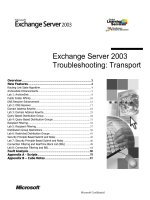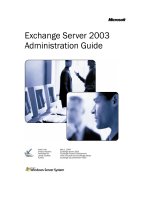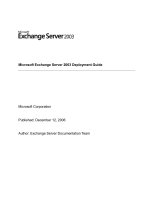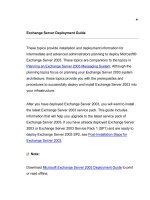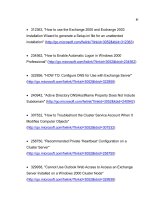vsphere-esxi-vcenter-server-501-troubleshooting-guide
Bạn đang xem bản rút gọn của tài liệu. Xem và tải ngay bản đầy đủ của tài liệu tại đây (886.63 KB, 64 trang )
vSphere Troubleshooting
Update 1
ESXi 5.0
vCenter Server 5.0
This document supports the version of each product listed and
supports all subsequent versions until the document is replaced
by a new edition. To check for more recent editions of this
document, see />EN-000849-00
vSphere Troubleshooting
2 VMware, Inc.
You can find the most up-to-date technical documentation on the VMware Web site at:
/>The VMware Web site also provides the latest product updates.
If you have comments about this documentation, submit your feedback to:
Copyright
©
2009–2012 VMware, Inc. All rights reserved. This product is protected by U.S. and international copyright and
intellectual property laws. VMware products are covered by one or more patents listed at
/>VMware is a registered trademark or trademark of VMware, Inc. in the United States and/or other jurisdictions. All other marks
and names mentioned herein may be trademarks of their respective companies.
VMware, Inc.
3401 Hillview Ave.
Palo Alto, CA 94304
www.vmware.com
Contents
About vSphere Troubleshooting 5
1
Troubleshooting Virtual Machines 7
Troubleshooting Fault Tolerant Virtual Machines 7
Troubleshooting USB Passthrough Devices 11
Recover Orphaned Virtual Machines in the vSphere Client 12
Recover Orphaned Virtual Machines in the vSphere Web Client 13
Virtual Machine Does Not Power On After Cloning or Deploying from Template 13
2
Troubleshooting Hosts 15
Troubleshooting vCenter Server and ESXi Host Certificates 15
Troubleshooting vSphere HA Host States 17
Troubleshooting Auto Deploy 21
Troubleshooting vCenter Server Plug-Ins 26
Linked Mode Troubleshooting 27
Configuring Logging for the VMware Inventory Service 29
Authentication Token Manipulation Error 29
Active Directory Rule Set Error Causes Host Profile Compliance Failure 30
3
Troubleshooting Clusters 31
Troubleshooting vSphere HA Admission Control 31
Troubleshooting Heartbeat Datastores 33
Troubleshooting vSphere HA Failovers 34
Troubleshooting vSphere Fault Tolerance in Network Partitions 36
Troubleshooting Storage I/O Control 37
Troubleshooting Storage DRS 39
Cannot Create Resource Pool When Connected Directly to Host 44
4
Troubleshooting Storage 45
Resolving SAN Storage Display Problems 45
Resolving SAN Performance Problems 47
Virtual Machines with RDMs Need to Ignore SCSI INQUIRY Cache 50
Software iSCSI Adapter Is Enabled When Not Needed 51
Failure to Mount NFS Datastores 51
Understanding SCSI Sense Codes 52
5
Troubleshooting Licensing 53
Troubleshooting Host Licensing 53
Troubleshooting License Reporting 55
Unable to Power On a Virtual Machine 58
Unable to Hot Plug Memory to a Virtual Machine 59
VMware, Inc.
3
Unable to Assign a License Key to vCenter Server 60
Unable to Configure or Use a Feature 60
Index 61
vSphere Troubleshooting
4 VMware, Inc.
About vSphere Troubleshooting
vSphere Troubleshooting describes troubleshooting issues and procedures for vCenter Server implementations
and related components.
Intended Audience
This information is for anyone who wants to troubleshoot virtual machines, ESXi hosts, clusters, and related
storage solutions. The information in this book is for experienced Windows or Linux system administrators
who are familiar with virtual machine technology and datacenter operations.
VMware, Inc. 5
vSphere Troubleshooting
6 VMware, Inc.
Troubleshooting Virtual Machines 1
The virtual machine troubleshooting topics provide solutions to potential problems that you might encounter
when using your virtual machines.
This chapter includes the following topics:
n
“Troubleshooting Fault Tolerant Virtual Machines,” on page 7
n
“Troubleshooting USB Passthrough Devices,” on page 11
n
“Recover Orphaned Virtual Machines in the vSphere Client,” on page 12
n
“Recover Orphaned Virtual Machines in the vSphere Web Client,” on page 13
n
“Virtual Machine Does Not Power On After Cloning or Deploying from Template,” on page 13
Troubleshooting Fault Tolerant Virtual Machines
To maintain a high level of performance and stability for your fault tolerant virtual machines and also to
minimize failover rates, you should be aware of certain troubleshooting issues.
The troubleshooting topics discussed focus on problems that you might encounter when using the vSphere
Fault Tolerance feature on your virtual machines. The topics also describe how to resolve problems.
You can also see the VMware knowledge base article at to help you
troubleshoot Fault Tolerance. This article contains a list of error messages that you might encounter when you
attempt to use the feature and, where applicable, advice on how to resolve each error.
Hardware Virtualization Not Enabled
You must enable Hardware Virtualization (HV) before you use vSphere Fault Tolerance.
Problem
When you attempt to power on a virtual machine with Fault Tolerance enabled, an error message might appear
if you did not enable HV.
Cause
This error is often the result of HV not being available on the ESXi server on which you are attempting to power
on the virtual machine. HV might not be available either because it is not supported by the ESXi server
hardware or because HV is not enabled in the BIOS.
VMware, Inc.
7
Solution
If the ESXi server hardware supports HV, but HV is not currently enabled, enable HV in the BIOS on that
server. The process for enabling HV varies among BIOSes. See the documentation for your hosts' BIOSes for
details on how to enable HV.
If the ESXi server hardware does not support HV, switch to hardware that uses processors that support Fault
Tolerance.
Compatible Hosts Not Available for Secondary VM
If you power on a virtual machine with Fault Tolerance enabled and no compatible hosts are available for its
Secondary VM, you might receive an error message.
Problem
The following error message might appear in the Recent Task Pane:
Secondary VM could not be powered on as there are no compatible hosts that can accommodate it.
Cause
This can occur for a variety of reasons including that there are no other hosts in the cluster, there are no other
hosts with HV enabled, data stores are inaccessible, there is no available capacity, or hosts are in maintenance
mode.
Solution
If there are insufficient hosts, add more hosts to the cluster. If there are hosts in the cluster, ensure they support
HV and that HV is enabled. The process for enabling HV varies among BIOSes. See the documentation for
your hosts' BIOSes for details on how to enable HV. Check that hosts have sufficient capacity and that they
are not in maintenance mode.
Secondary VM on Overcommitted Host Degrades Performance of Primary VM
If a Primary VM appears to be executing slowly, even though its host is lightly loaded and retains idle CPU
time, check the host where the Secondary VM is running to see if it is heavily loaded.
Problem
When a Secondary VM resides on a host that is heavily loaded, this can effect the performance of the Primary
VM.
Evidence of this problem could be if the vLockstep Interval on the Primary VM's Fault Tolerance panel is yellow
or red. This means that the Secondary VM is running several seconds behind the Primary VM. In such cases,
Fault Tolerance slows down the Primary VM. If the vLockstep Interval remains yellow or red for an extended
period of time, this is a strong indication that the Secondary VM is not getting enough CPU resources to keep
up with the Primary VM.
Cause
A Secondary VM running on a host that is overcommitted for CPU resources might not get the same amount
of CPU resources as the Primary VM. When this occurs, the Primary VM must slow down to allow the
Secondary VM to keep up, effectively reducing its execution speed to the slower speed of the Secondary VM.
Solution
To resolve this problem, set an explicit CPU reservation for the Primary VM at a MHz value sufficient to run
its workload at the desired performance level. This reservation is applied to both the Primary and Secondary
VMs ensuring that both are able to execute at a specified rate. For guidance setting this reservation, view the
performance graphs of the virtual machine (prior to Fault Tolerance being enabled) to see how much CPU
resources it used under normal conditions.
vSphere Troubleshooting
8 VMware, Inc.
Virtual Machines with Large Memory Can Prevent Use of Fault Tolerance
You can only enable Fault Tolerance on a virtual machine with a maximum of 64GB of memory.
Problem
Enabling Fault Tolerance on a virtual machine with more than 64GB memory can fail. Migrating a running
fault tolerant virtual machine using vMotion also can fail if its memory is greater than 15GB or if memory is
changing at a rate faster than vMotion can copy over the network.
Cause
This occurs if, due to the virtual machine’s memory size, there is not enough bandwidth to complete the
vMotion switchover operation within the default timeout window (8 seconds).
Solution
To resolve this problem, before you enable Fault Tolerance, power off the virtual machine and increase its
timeout window by adding the following line to the vmx file of the virtual machine:
ft.maxSwitchoverSeconds = "30"
where 30 is the timeout window in number in seconds. Enable Fault Tolerance and power the virtual machine
back on. This solution should work except under conditions of very high network activity.
NOTE If you increase the timeout to 30 seconds, the fault tolerant virtual machine might become unresponsive
for a longer period of time (up to 30 seconds) when enabling FT or when a new Secondary VM is created after
a failover.
Secondary VM CPU Usage Appears Excessive
In some cases, you might notice that the CPU usage for a Secondary VM is higher than for its associated Primary
VM.
Problem
When the Primary VM is idle, the relative difference between the CPU usage of the Primary and Secondary
VMs might seem large.
Cause
Replaying events (such as timer interrupts) on the Secondary VM can be slightly more expensive than recording
them on the Primary VM. This additional overhead is small.
Solution
None needed. Examining the actual CPU usage shows that very little CPU resource is being consumed by the
Primary VM or the Secondary VM.
Primary VM Suffers Out of Space Error
If the storage system you are using has thin provisioning built in, a Primary VM can crash when it encounters
an out of space error.
Problem
When used with a thin provisioned storage system, a Primary VM can crash. The Secondary VM replaces the
Primary VM, but the error message "There is no more space for virtual disk <disk_name>" appears on the
vSphere client.
Chapter 1 Troubleshooting Virtual Machines
VMware, Inc. 9
Cause
If thin provisioning is built into the storage system, it is not possible for ESX/ESXi hosts to know if enough disk
space has been allocated for a pair of fault tolerant virtual machines. If the Primary VM asks for extra disk
space but there is no space left on the storage, the primary VM crashes.
Solution
The error message gives you the choice of continuing the session by clicking "Retry" or clicking "Cancel" to
terminate the session. Ensure that there is sufficient disk space for the fault tolerant virtual machine pair and
click "Retry".
Fault Tolerant Virtual Machine Failovers
A Primary or Secondary VM can fail over even though its ESXi host has not crashed. In such cases, virtual
machine execution is not interrupted, but redundancy is temporarily lost. To avoid this type of failover, be
aware of some of the situations when it can occur and take steps to avoid them.
Partial Hardware Failure Related to Storage
This problem can arise when access to storage is slow or down for one of the hosts. When this occurs there are
many storage errors listed in the VMkernel log. To resolve this problem you must address your storage-related
problems.
Partial Hardware Failure Related to Network
If the logging NIC is not functioning or connections to other hosts through that NIC are down, this can trigger
a fault tolerant virtual machine to be failed over so that redundancy can be reestablished. To avoid this problem,
dedicate a separate NIC each for vMotion and FT logging traffic and perform vMotion migrations only when
the virtual machines are less active.
Insufficient Bandwidth on the Logging NIC Network
This can happen because of too many fault tolerant virtual machines being on a host. To resolve this problem,
more broadly distribute pairs of fault tolerant virtual machines across different hosts.
vMotion Failures Due to Virtual Machine Activity Level
If the vMotion migration of a fault tolerant virtual machine fails, the virtual machine might need to be failed
over. Usually, this occurs when the virtual machine is too active for the migration to be completed with only
minimal disruption to the activity. To avoid this problem, perform vMotion migrations only when the virtual
machines are less active.
Too Much Activity on VMFS Volume Can Lead to Virtual Machine Failovers
When a number of file system locking operations, virtual machine power ons, power offs, or vMotion
migrations occur on a single VMFS volume, this can trigger fault tolerant virtual machines to be failed over.
A symptom that this might be occurring is receiving many warnings about SCSI reservations in the VMkernel
log. To resolve this problem, reduce the number of file system operations or ensure that the fault tolerant virtual
machine is on a VMFS volume that does not have an abundance of other virtual machines that are regularly
being powered on, powered off, or migrated using vMotion.
Lack of File System Space Prevents Secondary VM Startup
Check whether or not your /(root) or /vmfs/datasource file systems have available space. These file systems can
become full for many reasons, and a lack of space might prevent you from being able to start a new Secondary
VM.
vSphere Troubleshooting
10 VMware, Inc.
Troubleshooting USB Passthrough Devices
Information about feature behavior can help you troubleshoot or avoid potential problems when USB devices
are connected to a virtual machine.
Error Message When You Try to Migrate Virtual Machine with USB Devices
Attached
Migration with vMotion cannot proceed and issues a confusing error message when you connect multiple USB
devices from an ESXi host to a virtual machine and one or more devices are not enabled for vMotion.
Problem
The Migrate Virtual Machine wizard runs a compatibility check before a migration operation begins. If
unsupported USB devices are detected, the compatibility check fails and an error message similar to the
following appears: Currently connected device 'USB 1' uses backing 'path:1/7/1', which is not
accessible.
Cause
When you connect USB devices from a host to a virtual machine, you must select all USB devices on the virtual
machine for migration for vMotion to be successful. If one or more devices are not enabled for vMotion,
migration will fail.
Solution
1 Make sure that the devices are not in the process of transferring data before removing them.
2 Re-add and enable vMotion for each affected USB device.
USB Passthrough Device Is Nonresponsive
USB devices can become nonresponsive for several reasons, including unsafely interrupting a data transfer or
if a guest operating system driver sends an unsupported command to the device.
Problem
The USB device is nonresponsive.
Cause
A data transfer was interrupted or nonsupported devices are being used. For example, if a guest driver sends
a SCSI REPORT LUNS command to some unsupported USB flash drives, the device stops responding to all
commands.
Solution
1 Physically detach the USB device from the ESXi host and reattach it.
2 Fully shut down the host (not reset) and leave it powered off for at least 30 seconds to ensure that the host
USB bus power is fully powered down.
Chapter 1 Troubleshooting Virtual Machines
VMware, Inc. 11
Cannot Copy Data From an ESXi Host to a USB Device That Is Connected to the
Host
You can connect a USB device to an ESXi host and copy data to the device from the host. For example, you
might want to gather the vm-support bundle from the host after the host loses network connectivity. To perform
this task, you must stop the USB arbitrator.
Problem
If the USB arbitrator is being used for USB passthrough from an ESXi host to a virtual machine, or if the USB
device is formatted with a FAT16 partition and is the maximum size of 2GB, the USB device appears under
lsusb but does not mount correctly.
Cause
This problem occurs because the usbarbitrator service has claimed the device to make it available for
passthrough from the host to virtual machines.
Solution
1 Stop the usbarbitrator service:/etc/init.d/usbarbitrator stop
2 Disconnect and reconnect the USB device.
By default, the device location is /vmfs/devices/disks/mpx.vmhbaXX:C0:T0:L0.
After using the device, restart the usbarbitrator service:/etc/init.d/usbarbitrator start
Recover Orphaned Virtual Machines in the vSphere Client
Virtual machines appear in the vSphere Client inventory list with (orphaned) appended to their name.
Problem
Virtual machines that reside on an ESXi host managed by vCenter Server might become orphaned in rare cases.
Such virtual machines exist in the vCenter Server database, but the ESXi host no longer recognizes them.
Cause
Virtual machines can become orphaned if a host failover is unsuccessful, or when the virtual machine is
unregistered directly on the host. If this situation occurs, move the orphaned virtual machine to another host
in the datacenter that has access to the datastore on which the virtual machine files are stored.
Solution
1 In the vSphere Client inventory list, right-click the virtual machine and select Relocate.
A list of available hosts appears.
2 Select the host on which to place the virtual machine.
If no hosts are available, add a host that can access the datastore on which the virtual machine's files are
stored.
3 Click OK to save your changes.
The virtual machine is connected to the new host and appears in the inventory list.
vSphere Troubleshooting
12 VMware, Inc.
Recover Orphaned Virtual Machines in the vSphere Web Client
Virtual machines appear in the vSphere Web Client inventory list with (orphaned) appended to their name.
Problem
Virtual machines that reside on an ESXi host managed by vCenter Server might become orphaned in rare cases.
Such virtual machines exist in the vCenter Server database, but the ESXi host no longer recognizes them.
Cause
Virtual machines can become orphaned if a host failover is unsuccessful, or when the virtual machine is
unregistered directly on the host. If this situation occurs, move the orphaned virtual machine to another host
in the datacenter that has access to the datastore on which the virtual machine files are stored.
Solution
1 In the vSphere Web Client inventory list, right-click the virtual machine and select Migrate.
A list of available hosts appears.
2 Select the host on which to place the virtual machine.
If no hosts are available, add a host that can access the datastore on which the virtual machine's files are
stored.
3 Click OK to save your changes.
The virtual machine is connected to the new host and appears in the inventory list.
Virtual Machine Does Not Power On After Cloning or Deploying from
Template
Virtual machines do not power on after you complete the clone or deploy from template workflow.
Problem
When you clone a virtual machine or deploy a virtual machine from a template, you can select the Power on
this virtual machine after creation check box on the Ready to Complete page. However, the virtual machine
might not automatically power on upon creation.
Cause
The swap file size is not reserved when the virtual machine disks are created.
Solution
n
Reduce the size of the swap file that is required for the virtual machine. You can do this by increasing the
virtual machine memory reservation.
a In the vSphere Client inventory, right-click the virtual machine and select Edit Settings.
b Select the Resources tab and click Memory.
c Use the Reservation slider to increase the amount of memory allocated to the virtual machine.
d Click OK.
n
Alternatively, you can increase the amount of space available for the swap file by moving other virtual
machine disks off of the datastore that is being used for the swap file.
a In the vSphere Client inventory, select the datastore and click the Virtual Machines tab.
b For each virtual machine to move, right-click the virtual machine and select Migrate.
Chapter 1 Troubleshooting Virtual Machines
VMware, Inc. 13
c Select Change datastore.
d Proceed through the Migrate Virtual Machine wizard.
n
You can also increase the amount of space available for the swap file by changing the swap file location
to a datastore with adequate space.
a In the vSphere Client inventory, select the host and click the Configuration tab.
b Under Software, select Virtual Machine Swapfile Location.
c Click Edit.
NOTE If the host is part of a cluster that specifies that the virtual machine swap files are stored in the
same directory as the virtual machine, you cannot click Edit. You must use the Cluster Settings dialog
box to change the swap file location policy for the cluster.
d Select a datastore from the list and click OK.
vSphere Troubleshooting
14 VMware, Inc.
Troubleshooting Hosts 2
The host troubleshooting topics provide solutions to potential problems that you might encounter when using
your vCenter Servers and ESXi hosts.
This chapter includes the following topics:
n
“Troubleshooting vCenter Server and ESXi Host Certificates,” on page 15
n
“Troubleshooting vSphere HA Host States,” on page 17
n
“Troubleshooting Auto Deploy,” on page 21
n
“Troubleshooting vCenter Server Plug-Ins,” on page 26
n
“Linked Mode Troubleshooting,” on page 27
n
“Configuring Logging for the VMware Inventory Service,” on page 29
n
“Authentication Token Manipulation Error,” on page 29
n
“Active Directory Rule Set Error Causes Host Profile Compliance Failure,” on page 30
Troubleshooting vCenter Server and ESXi Host Certificates
Certificates are automatically generated when you install vCenter Server. These default certificates are not
signed by a commercial certificate authority (CA) and might not provide strong security. You can replace
default vCenter Server certificates with certificates signed by a commercial CA. When you replace vCenter
Server and ESXi certificates, you might encounter errors.
vCenter Server Cannot Connect to the Database
After you replace default vCenter Server certificates, you might be unable to connect to the vCenter Server
database.
Problem
vCenter Server is unable to connect to the vCenter Server database, and therefore cannot be restarted after you
replace default vCenter Server certificates.
Cause
The database password must be reset.
Solution
Reset the database password by running the following command: vpxd -P pwd.
VMware, Inc.
15
vCenter Server Cannot Connect to Managed Hosts
After you replace default vCenter Server certificates and restart the system, vCenter Server might not be able
to connect to managed hosts.
Problem
vCenter Server cannot connect to managed hosts after server certificates are replaced and the system is
restarted.
Solution
Log into the host as the root user and reconnect the host to vCenter Server.
New vCenter Server Certificate Does Not Appear to Load
After you replace default vCenter Server certificates, the new certificates might not appear to load.
Problem
When you install new vCenter Server certificates, you might not see the new certificate.
Cause
Existing open connections to vCenter Server are not forcibly closed and might still use the old certificate.
Solution
To force all connections to use the new certificate, use one of the following methods.
n
Restart the network stack or network interfaces on the server.
n
Restart the vCenter Server service.
Regenerate Certificates for an ESXi Host
Under certain circumstances, you might be required to force the host to generate new certificates.
Problem
You might need to generate new certificates if you change the host name or accidentally delete a certificate.
Solution
1 Log in to the ESXi Shell as a user with administrator privileges.
2 In the directory /etc/vmware/ssl, back up any existing certificates by renaming them using the following
commands.
mv rui.crt orig.rui.crt
mv rui.key orig.rui.key
NOTE If you are regenerating certificates because you have deleted them, this step is unnecessary.
3 Run the command /sbin/generate-certificates to generate new certificates.
4 Run the command /etc/init.d/hostd restart to restart the hostd process.
5 Confirm that the host successfully generated new certificates by using the following command and
comparing the time stamps of the new certificate files with orig.rui.crt and orig.rui.key.
ls -la
vSphere Troubleshooting
16 VMware, Inc.
Cannot Configure vSphere HA When Using Custom SSL Certificates
After you install custom SSL certificates, attempts to enable vSphere High Availability (HA) fail.
Problem
When you attempt to enable vSphere HA on a host with custom SSL certificates installed, the following error
message appears: vSphere HA cannot be configured on this host because its SSL thumbprint has not
been verified.
Cause
When you add a host to vCenter Server, and vCenter Server already trusts the host's SSL certificate,
VPX_HOST.EXPECTED_SSL_THUMBPRINT is not populated in the vCenter Server database. vSphere HA obtains the
host's SSL thumbprint from this field in the database. Without the thumbprint, you cannot enable vSphere HA.
Solution
1 In the vSphere Client, disconnect the host that has custom SSL certificates installed.
2 Reconnect the host to vCenter Server.
3 Accept the host's SSL certificate.
4 Enable vSphere HA on the host.
Troubleshooting vSphere HA Host States
vCenter Server reports vSphere HA host states that indicate an error condition on the host. Such errors can
prevent vSphere HA from fully protecting the virtual machines on the host and can impede vSphere HA's
ability to restart virtual machines after a failure. Errors can occur when vSphere HA is being configured or
unconfigured on a host or, more rarely, during normal operation. When this happens, you should determine
how to resolve the error, so that vSphere HA is fully operational.
vSphere HA Agent Is in the Agent Unreachable State
The vSphere HA agent on a host is in the Agent Unreachable state for a minute or more. User intervention
might be required to resolve this situation.
Problem
vSphere HA reports that an agent is in the Agent Unreachable state when the agent for the host cannot be
contacted by the master host or by vCenter Server. Consequently, vSphere HA is not able to monitor the virtual
machines on the host and might not restart them after a failure.
Cause
A vSphere HA agent can be in the Agent Unreachable state for several reasons. This condition most often
indicates that a networking problem is preventing vCenter Server from contacting the master host and the
agent on the host, or that all hosts in the cluster have failed. This condition can also indicate the unlikely
situation that vSphere HA was disabled and then re-enabled on the cluster while vCenter Server could not
communicate with the vSphere HA agent on the host, or that the agent on the host has failed, and the watchdog
process was unable to restart it.
Solution
Determine if vCenter Server is reporting the host as not responding. If so, there is a networking problem or a
total cluster failure. After either condition is resolved, vSphere HA should work correctly. If not, reconfigure
vSphere HA on the host. Similarly, if vCenter Server reports the hosts are responding but a host's state is Agent
Unreachable, reconfigure vSphere HA on that host.
Chapter 2 Troubleshooting Hosts
VMware, Inc. 17
vSphere HA Agent is in the Uninitialized State
The vSphere HA agent on a host is in the Uninitialized state for a minute or more. User intervention might be
required to resolve this situation.
Problem
vSphere HA reports that an agent is in the Uninitialized state when the agent for the host is unable to enter
the run state and become the master host or to connect to the master host. Consequently, vSphere HA is not
able to monitor the virtual machines on the host and might not restart them after a failure.
Cause
A vSphere HA agent can be in the Uninitialized state for one or more reasons. This condition most often
indicates that the host does not have access to any datastores. Less frequently, this condition indicates that the
host does not have access to its local datastore on which vSphere HA caches state information, the agent on
the host is inaccessible, or the vSphere HA agent is unable to open required firewall ports.
Solution
Search the list of the host's events for recent occurrences of the event vSphere HA Agent for the host has an
error. This event indicates the reason for the host being in the uninitialized state. If the condition exists because
of a datastore problem, resolve whatever is preventing the host from accessing the affected datastores. After
the problem has been resolved, if the agent does not return to an operational state, reconfigure vSphere HA
on the host.
NOTE If the condition exists because of a firewall problem, check if there is another service on the host that is
using port 8192. If so, shut down that service, and reconfigure vSphere HA.
vSphere HA Agent is in the Initialization Error State
The vSphere HA agent on a host is in the Initialization Error state for a minute or more. User intervention is
required to resolve this situation.
Problem
vSphere HA reports that an agent is in the Initialization Error state when the last attempt to configure vSphere
HA for the host failed. vSphere HA does not monitor the virtual machines on such a host and might not restart
them after a failure.
Cause
This condition most often indicates that vCenter Server was unable to connect to the host while the vSphere
HA agent was being installed or configured on the host. This condition might also indicate that the installation
and configuration completed, but the agent did not become a master host or a slave host within a timeout
period. Less frequently, the condition is an indication that there is insufficient disk space on the host's local
datastore to install the agent, or that there are insufficient unreserved memory resources on the host for the
agent resource pool. Finally, for ESXi 5.0 hosts, the configuration fails if a previous installation of another
component required a host reboot, but the reboot has not yet occurred.
Solution
When a Configure HA task fails, a reason for the failure is reported.
vSphere Troubleshooting
18 VMware, Inc.
Reason for Failure Action
Host communication
errors
Resolve any communication problems with the host and retry the configuration operation.
Timeout errors Possible causes include that the host crashed during the configuration task, the agent failed to
start after being installed, or the agent was unable to initialize itself after starting up. Verify that
vCenter Server is able to communicate with the host. If so, see “vSphere HA Agent Is in the Agent
Unreachable State,” on page 17 or “vSphere HA Agent is in the Uninitialized State,” on page 18
for possible solutions.
Lack of file space Free up approximately 75MB of disk space. If the failure is due to insufficient unreserved memory,
free up memory on the host by either relocating virtual machines to another host or reducing
their reservations. In either case, retry the vSphere HA configuration task after resolving the
problem.
Reboot pending If an installation for a 5.0 or later host fails because a reboot is pending, reboot the host and retry
the vSphere HA configuration task.
vSphere HA Agent is in the Uninitialization Error State
The vSphere HA agent on a host is in the Uninitialization Error state. User intervention is required to resolve
this situation.
Problem
vSphere HA reports that an agent is in the Uninitialization Error state when vCenter Server is unable to
unconfigure the agent on the host during the Unconfigure HA task. An agent left in this state can interfere
with the operation of the cluster. For example, the agent on the host might elect itself as master host and lock
a datastore. Locking a datastore prevents the valid cluster master host from managing the virtual machines
with configuration files on that datastore.
Cause
This condition usually indicates that vCenter Server lost the connection to the host while the agent was being
unconfigured.
Solution
Add the host back to vCenter Server (version 5.0 or later). The host can be added as a stand-alone host or added
to any cluster.
vSphere HA Agent is in the Host Failed State
The vSphere HA agent on a host is in the Host Failed state. User intervention is required to resolve the situation.
Problem
Usually, such reports indicate that a host has actually failed, but failure reports can sometimes be incorrect. A
failed host reduces the available capacity in the cluster and, in the case of an incorrect report, prevents vSphere
HA from protecting the virtual machines running on the host.
Cause
This host state is reported when the vSphere HA master host to which vCenter Server is connected is unable
to communicate with the host and with the heartbeat datastores that are in use for the host. Any storage failure
that makes the datastores inaccessible to hosts can cause this condition if accompanied by a network failure.
Solution
Check for the noted failure conditions and resolve any that are found.
Chapter 2 Troubleshooting Hosts
VMware, Inc. 19
vSphere HA Agent is in the Network Partitioned State
The vSphere HA agent on a host is in the Network Partitioned state. User intervention might be required to
resolve this situation.
Problem
While the virtual machines running on the host continue to be monitored by the master hosts that are
responsible for them, vSphere HA's ability to restart the virtual machines after a failure is affected. First, each
master host has access to a subset of the hosts, so less failover capacity is available to each host. Second, vSphere
HA might be unable to restart a Secondary VM after a failure (see “Primary VM Remains in the Need Secondary
State,” on page 36).
Cause
A host is reported as partitioned if both of the following conditions are met:
n
The vSphere HA master host to which vCenter Server is connected is unable to communicate with the
host by using the management network, but is able to communicate with that host by using the heartbeat
datastores that have been selected for it.
n
The host is not isolated.
A network partition can occur for a number of reasons including incorrect VLAN tagging, the failure of a
physical NIC or switch, configuring a cluster with some hosts that use only IPv4 and others that use only IPv6,
or the management networks for some hosts were moved to a different virtual switch without first putting the
host into maintenance mode.
Solution
Resolve the networking problem that prevents the hosts from communicating by using the management
networks.
vSphere HA Agent is in the Network Isolated State
The vSphere HA agent on a host is in the Network Isolated state. User intervention is required to resolve this
situation.
Problem
When a host is in the Network Isolated state, vSphere HA applies the power-off or shutdown host isolation
response to virtual machines running on the host. vSphere HA continues to monitor the virtual machines that
are left powered on. While a host is in this state, vSphere HA's ability to restart virtual machines after a failure
is affected. vSphere HA only powers off or shuts down a virtual machine if the agent on the host determines
that a master host is responsible for the virtual machine.
Cause
A host is network isolated if both of the following conditions are met:
n
Isolation addresses have been configured and the host is unable to ping them.
n
The vSphere HA agent on the host is unable to access any of the agents running on the other cluster hosts.
Solution
Resolve the networking problem that is preventing the host from pinging its isolation addresses and
communicating with other hosts.
vSphere Troubleshooting
20 VMware, Inc.
Troubleshooting Auto Deploy
The Auto Deploy troubleshooting topics offer solutions for situations when provisioning hosts with Auto
Deploy does not work as expected.
Auto Deploy TFTP Timeout Error at Boot Time
A TFTP Timeout error message appears when a host provisioned by Auto Deploy boots. The text of the message
depends on the BIOS.
Problem
A TFTP Timeout error message appears when a host provisioned by Auto Deploy boots. The text of the message
depends on the BIOS.
Cause
The TFTP server is down or unreachable.
Solution
u
Ensure that your TFTP service is running and reachable by the host that you are trying to boot.
Auto Deploy Host Boots with Wrong Configuration
A host is booting with a different ESXi image, host profile, or folder location than the one specified in the rules.
Problem
A host is booting with a different ESXi image profile or configuration than the image profile or configuration
that the rules specify. For example, you change the rules to assign a different image profile, but the host still
uses the old image profile.
Cause
After the host has been added to a vCenter Server system, the boot configuration is determined by the vCenter
Server system. The vCenter Server system associates an image profile, host profile, or folder location with the
host.
Solution
u
Use the Test-DeployRuleSetCompliance and Repair-DeployRuleSetCompliance PowerCLI cmdlets to
reevalute the rules and to associate the correct image profile, host profile, or folder location with the host.
Host Is Not Redirected to Auto Deploy Server
During boot, a host that you want to provision with Auto Deploy loads gPXE. The host is not redirected to the
Auto Deploy server.
Problem
During boot, a host that you want to provision with Auto Deploy loads gPXE. The host is not redirected to the
AutoDeploy server.
Cause
The tramp file that is included in the TFTP ZIP file has the wrong IP address for the Auto Deploy server.
Chapter 2 Troubleshooting Hosts
VMware, Inc. 21
Solution
u
Correct the IP address of the Auto Deploy server in the tramp file, as explained in the vSphere Installation
and Setup documentation.
Package Warning Message When You Assign an Image Profile to Auto Deploy
Host
When you run a PowerCLI cmdlet that assigns an image profile that is not Auto Deploy ready, a warning
message appears.
Problem
When you write or modify rules to assign an image profile to one or more hosts, the following error results:
Warning: Image Profile <name-here> contains one or more software packages that are not stateless-
ready. You may experience problems when using this profile with Auto Deploy.
Cause
Each VIB in an image profile has a stateless-ready flag that indicates that the VIB is meant for use with Auto
Deploy. You get the error if you attempt to write an Auto Deploy rule that uses an image profile in which one
or more VIBs have that flag set to FALSE.
NOTE You can use hosts provisioned with Auto Deploy that include VIBs that are not stateless ready without
problems. However booting with an image profile that includes VIBs that are not stateless ready is treated like
a fresh install. Each time you boot the host, you lose any configuration data that would otherwise be available
across reboots for hosts provisioned with Auto Deploy.
Solution
1 Use Image Builder PowerCLI cmdlets to view the VIBs in the image profile.
2 Remove any VIBs that are not stateless-ready.
3 Rerun the Auto Deploy PowerCLI cmdlet.
Auto Deploy Host with a Built-In USB Flash Drive Does Not Send Coredumps to
Local Disk
If your Auto Deploy host has a built-in USB flash drive, and an error results in a coredump, the coredump is
lost. Set up your system to use ESXi Dump Collector to store coredumps on a networked host.
Problem
If your Auto Deploy host has a built-in USB Flash, and if it encounters an error that results in a coredump, the
coredump is not sent to the local disk.
Solution
1 Install ESXi Dump collector on a system of your choice.
ESXi Dump Collector is included with the vCenter Server installer.
2 Use ESXCLI to configure the host to use ESXi Dump Collector.
esxcli
conn_options
system coredump network set
IP-addr,port
esxcli system coredump network set -e true
3 Use ESXCLI to disable local coredump partitions.
esxcli
conn_options
system coredump partition set -e false
vSphere Troubleshooting
22 VMware, Inc.
vmware-fdm Warning Message When You Assign an Image Profile to Auto Deploy
Host
When users run PowerCLI cmdlets that assign an image profile to one or more hosts, an error results if the
vmware-fdm package is not part of the image profile. This package is required if you use the Auto Deploy host
with vSphere HA.
Problem
When users write or modify rules to assign an image profile to one or more Auto Deploy hosts, the following
error appears:
WARNING: The supplied image profile does not contain the "vmware-fdm" software
package, which is required for the vSphere HA feature. If this image profile
is to be used with hosts in a vSphere HA cluster, you should add the vmware-fdm
package to the image profile. The vmware-fdm package can be retrieved from the
software depot published by this vCenter Server at the following URL:
http://<VC-Address>/vSphere-HA-depot
You can use the Add-EsxSoftwarePackage cmdlet to add the package to the image
profile and then update any hosts or rules that were using the older version
of the profile.
Cause
The image profile does not include the vmware-fdm software package, which is required by vSphere HA.
Solution
If you will not use the Auto Deploy hosts in an environment that uses vSphere HA, you can ignore the warning.
If you will use the Auto Deploy hosts in an environment that uses vSphere HA, follow the instructions in the
warning.
1 At the PowerCLI command prompt, add the software depot that includes the vmware-fmd package.
Add-EsxSoftwareDepot http://VC-Address/vSphere-HA-depot
2 (Optional) If the image profile that generated the warning is read-only, clone the image profile.
New-EsxImageProfile -CloneProfile My_Profile -name "Test Profile Error Free"
This example clones the profile named My-Profile and assigns it the name Test Profile Error Free.
3 Run Add-EsxSoftwarePackage to add the package to the image profile.
Add-EsxSoftwarePackage -ImageProfile "Test Profile Error Free" -SoftwarePackage vmware-fdm
Chapter 2 Troubleshooting Hosts
VMware, Inc. 23
Auto Deploy Host Reboots After Five Minutes
An Auto Deploy host boots and displays gPXE information, but reboots after five minutes.
Problem
A host to be provisioned with Auto Deploy boots from gPXE and displays gPXE information on the console.
However, after five minutes, the host displays the following message to the console and reboots.
This host is attempting to network-boot using VMware
AutoDeploy. However, there is no ESXi image associated with this host.
Details: No rules containing an Image Profile match this
host. You can create a rule with the New-DeployRule PowerCLI cmdlet
and add it to the rule set with Add-DeployRule or Set-DeployRuleSet.
The rule should have a pattern that matches one or more of the attributes
listed below.
The host might also display the following details:
Details: This host has been added to VC, but no Image Profile
is associated with it. You can use Apply-ESXImageProfile in the
PowerCLI to associate an Image Profile with this host.
Alternatively, you can reevaluate the rules for this host with the
Test-DeployRuleSetCompliance and Repair-DeployRuleSetCompliance cmdlets.
The console then displays the host's machine attributes including vendor, serial number, IP address, and so
on.
Cause
No image profile is currently associated with this host.
Solution
You can temporarily assign an image profile to the host by running the Apply-EsxImageProfile cmdlet.
You can permanently assign an image profile to the host as follows.
1 Run the New-DeployRule cmdlet to create a rule that includes a pattern that matches the host with an image
profile.
2 Run the Add-DeployRule cmdlet to add the rule to a ruleset.
3 Run the Test-DeployRuleSetCompliance cmdlet and use the output of that cmdlet as the input to the
Repair-DeployRuleSetCompliance cmdlet.
See vSphere Installation and Setup documentation for details about vSphere Auto Deploy.
Auto Deploy Host Cannot Contact TFTP Server
The host you provision with Auto Deploy cannot contact the TFTP server.
Problem
When you attempt to boot a host provisioned with Auto Deploy, the host performs a network boot and is
assigned a DHCP address by the DHCP server, but the host cannot contact the TFTP server.
Cause
The TFTP server might have stopped running, or a firewall might block the TFTP port.
vSphere Troubleshooting
24 VMware, Inc.
Solution
n
If you installed the WinAgents TFTP server, open the WinAgents TFTP management console and verify
that the service is running. If the service is running, check the Windows firewall's inbound rules to make
sure the TFTP port is not blocked. Turn off the firewall temporarily to see whether the firewall is the
problem.
n
For all other TFTP servers, see the server documentation for debugging procedures.
Auto Deploy Host Cannot Retrieve ESXi Image from Auto Deploy Server
The host you provision with Auto Deploy stops at the gPXE boot screen.
Problem
When you attempt to boot a host provisioned with Auto Deploy, the boot process stops at the gPXE boot screen
and the status message indicates that the host is attempting to get the ESXi image from the Auto Deploy server.
Cause
The Auto Deploy service might be stopped or the Auto Deploy server might be unaccessible.
Solution
1 Log in to the system on which you installed the Auto Deploy server.
2 Check that the Auto Deploy server is running.
a Click Start > Settings > Control Panel > Administrative Tools.
b Double-click Services to open the Services Management panel.
c In the Services field, look for the VMware vSphere Auto Deploy Waiter service and restart it if it is
not running.
3 Open a Web browser and enter the following URL and check whether the Auto Deploy server is accessible.
https://Auto_Deploy_Server_IP_Address:Auto_Deploy_Server_Port/vmw/rdb
NOTE Use this address only to check whether the server is accessible.
4 If the server is not accessible, a firewall problem is likely.
a Try setting up permissive TCP Inbound rules for the Auto Deploy server port.
The port is 6501 unless you specified a different port during installation.
b As a last resort, disable the firewall temporarily and enable it again after you verified whether it
blocked the traffic. Do not disable the firewall on production environments.
To disable the firewall, run netsh firewall set opmode disable. To enable the firewall, run
netsh firewall set opmode enable.
Auto Deploy Host Does Not Get a DHCP Assigned Address
The host you provision with Auto Deploy fails to get a DHCP Address.
Problem
When you attempt to boot a host provisioned with Auto Deploy, the host performs a network boot but is not
assigned a DHCP address. The Auto Deploy server cannot provision the host with the image profile.
Cause
You might have a problem with the DHCP service or with the firewall setup.
Chapter 2 Troubleshooting Hosts
VMware, Inc. 25
